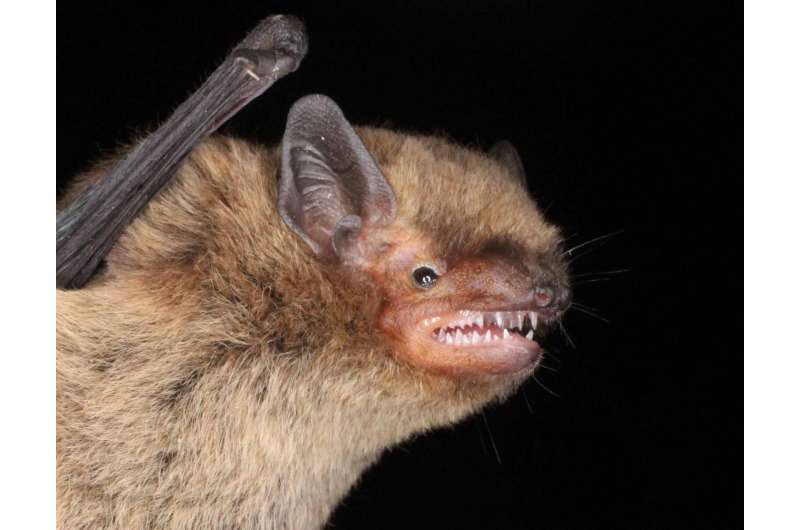A portrait picture of a soprano bat (Pipistrellus pygmaeus). Credit: Christian Voigt
Some migratory bats are attracted to artificial green light which may interfere with their flight paths, according to a study published May 31, 2017 in the open-access journal PLOS ONE by Christian Voigt from the Leibniz Institute for Zoo and Wildlife Research and the Free University of Berlin, Germany, and colleagues.
Artificial light at night is increasing worldwide, and is thought to affect bats. Some migrating birds are also known to become disorientated, particularly by red and white light, risking collisions with light sources and wasted energy from unnecessary detours. This has led to recommendations to use blue and green light for illumination, but the effect of this light on bats had not been established.
The authors of the present study therefore exposed bats migrating south along Latvia's shoreline at night to brief periods of artificial green light at a wavelength of 520nm, and recorded and analyzed bats' echolocation calls during lit and unlit intervals to assess the impact of the light.
The researchers found that the two most abundant migrating bat species detected, Nathusius' bats (Pipistrellus nathusii) and Soprano bats (P. pygmaeus), were attracted to the green light, with an increase of 54 percent and 47 percent respectively in the bats' calling activity near the light source when it was illuminated.
It had previously been unclear whether bats were attracted to the light itself, or to their insect prey which may itself be drawn to the light. In this study, the light affected the echolocation of bats up to 23m away, too far for the bats to detect insects near the light, and the proportion of calls which were hunting-related 'feeding buzzes' did not increase in the presence of green light. Thus, the researchers suggest that these migratory bats are attracted to green light directly and not because of the insects which gather around it.
This research suggests that certain migratory bats are affected by green light and that it could interfere with their flight paths and even lead to increased collisions, making this susceptibility an important consideration when designing night time illumination.
More information: Voigt CC, Roeleke M, Marggraf L, Pētersons G, Voigt-Heucke SL (2017) Migratory bats respond to artificial green light with positive phototaxis. PLoS ONE 12(5): e0177748. doi.org/10.1371/journal.pone.0177748
Journal information: PLoS ONE
Provided by Public Library of Science
























